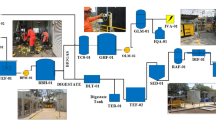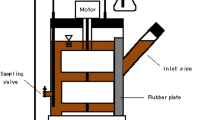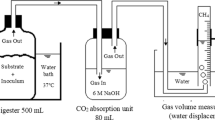Summary
Novel, laboratory-scale, high solids reactors operated under mesophilic conditions were used to study the anaerobic fermentation of processed municipal solid waste (MSW) to methane. The anaerobic digestion consortium was introduced to high solids levels through gradual adaptation. The maximum sludge solids level for stable anaerobic fermentation performance was identified as approximately 36% wt/wt. Recovery of the anaerobic consortium, following dilution of inhibitory high solids levels, was swift. Reactor mixing requirements were also studied. No significant difference in fermentation performance was observed between agitator speeds of 1 and 25 rpm. Preliminary fermentation performance tests showed that solids loading rates as high as 9.5 g VS (volatile solids) feed/L sludge.d, at 32% solids within the reactor, were possible. Under these conditions, operation was stable with an average pH of 7.8–8.0, total volatile fatty acid pools of <20 mM, and a biogas composition of 55%–60% methane.
Similar content being viewed by others
References
Begouen, O., Thiebaut, E., Pavia, A., and Peillex, J.P. (1988). Thermophilic Anaerobic Digestion of Municipal Solid Waste by the Valorga Process. In:Proceedings of the Fifth International Symposium on Anaerobic Digestion, May 22–26, Bologna, Italy, pp. 789–792.
de Baere, L. and Verstraete, W. (1984). High-Rate Anaerobic Composting with Biogas Recovery.Biocycle 25, 30–31.
Gaddy, J.L. and Clausen, E.C. (1985).SERI Anaerobic Digestion Program 1984 Annual Report. SERI/PR-231-2691.
Ghosh, S. (1985). Leach-bed Two-phase Digestion—The LanFilgas Concept. In:Proceedings of the Ninth Annual Symposium on Energy From Biomass and Wastes, Jan. 28–1 Feb., Lake Buena Vista, FL. pp. 743-761.
Goebel, R.P. (1983). High Solids Anaerobic Digester for Rural Use.US DOE Technical Report. #DE-FG03-81 SF 11613.
Goering, H.K. and Van Soest, P.J. (1970). Forest Fiber Analysis (Apparatus, Reagents, Procedures, and Some Applications).U.S. Dept. of Agriculture Handbook #379.
Goldberg, T., Bjergbaek, B., Djernaes, E., and Mouritzen, A. (1981). An Anaerobic Digester for Continual High Solid Loading: The Bio-Funnel (A Radially Expanding, Overflow Digester). In:Proceedings of the International Gas Research Conference Chicago, IL, pp. 734–741.
Hall, S.J., Hawkes, D.L., Hawkes, F.R., and Thomas, A. (1985). Mesophilic Anaerobic Digestion of High Solids Cattle Waste in a Packed Bed Digester.J. Agric. Eng. Res. 32, 153–162.
Jewell, W.J. (1980). Anaerobic Fermentation of Agricultural Residue, Potential for Improvement and Implementation. Volume II,US DOE Project. #DE-AC02-76ET20051.
Lin, Y.-M. (1983). Coupled High Solids Fermentation and Anaerobic Filtration of Cellulosic Residues. Ph.D. Thesis, Michigan State University.
Meenen, P.Van, Vermeulen, J., and Verstraete, W. (1988). Fragility of Anaerobic SSF Consortia. In:Proceedings of the Fifth International Symposium on Anaerobic Digestion, May 22–26, Bologna, Italy, pp. 345–356.
Molnar, L. and Bartha, I. (1988). High Solids Anaerobic Fermentation for Biogas and Compost Production.Biomass. 16, 173–182.
Owen, W.F., Stuckey, D.C., Healy, J.B., Young, L.Y., and McCarty, P.L. (1979). Bioassay for Monitoring Biochemical Methane Potential and Anaerobic Toxicity.Water Res. 13, 485–492.
Rivard, C.J., Himmel, M.E., Vinzant, T.B., Adney, W.S. Wyman, C.E., and Grohmann, K. (1989). Development of a Novel Laboratory Scale High Solids Reactor for Anaerobic Digestion of Processed Municipal Solid Wastes for the Production of Methane.Appl. Biochem. and Biotech. 20/21, 461–478.
Snell Environmental Group (1983). Rapid Methane Generation from Solid Waste.US DOE Technical Report. #DE-FG02-71R510329.
Wujcik, W.J. and Jewell, W.J. (1979). Dry Anaerobic Fermentation. In:Proceedings from the Second Symposium on Biotechnology in Energy Production and Conservation. October 3–5, Gatlinburg, TN, pp. 43–65.
Author information
Authors and Affiliations
Rights and permissions
About this article
Cite this article
Rivard, C.J., Himmel, M.E., Vinzant, T.B. et al. Anaerobic digestion of processed municipal solid waste using a novel high solids reactor: Maximum solids levels and mixing requirements. Biotechnol Lett 12, 235–240 (1990). https://doi.org/10.1007/BF01026806
Issue Date:
DOI: https://doi.org/10.1007/BF01026806




